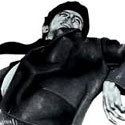
Panic Attack! Art In The Punk Years
by Mark Sladen and Ariella Yedgar (editors)
Merrell Publishers

Lest another dodgy punk milestone (30th anniversary of Nevermind the Bollocks zzzzzzz) has you feeling absolutely suicidal about how a once vital and dangerous outsider movement is now being sucked absolutely dry by the nostalgist faction of the media establishment…. Well, friends, Panic Attack is going to make you feel a whole helluva lot better by reminding you that the roots of punk were in total freaks, artists, minorities and outsiders – just where they belong. Panic Attack shifts the argument away from the increasing retrospective turf war between New York and London and instead focuses on the similarities between the two (as well as other like-minded outposts in the US and Europe).
In the mid-1970s, it seemed the very fabric of society in New York and London was unraveling, the terrain seemed to shift, the rules and authorities seemed to disappear and the weirdos had the keys to the castle – kings and queens of a deserted urban wasteland. They could dance, oh they could dance in the ruins – the adults were gone and the world was theirs. And what a world of creativity it spawned – far more choice than the stern grays of the Stranglers or the Clash, these were vibrant experiments in visual art and performance transgression. Future stars made their names in this uncertain terrain – Jean-Michel Basquiat, Keith Haring and Nan Goldin. A nascent Throbbing Gristle started out as the multimedia terrorgroup COUM Transmissions – one of its more notable exhibits being Cosey Fanni Tutti’s “guerilla” infiltrations as a model for cheapo skin mags and framing the resultant centerfolds in the halls of the ICA. Note also that the riotous (almost literally) opening night of the display was attended by the cream of emergent punk royalty. Such was the air of give-and-take in the streets of London and New York; artists would take in all the latest soundz at whatever crappy club, rush home, and begin working. Or the artists would inspire the punkers to try new strategies and experiments in their own work – crossing over with album covers and collaborations. Alternately, artists who had no dealings or crossover with punk (in this book) still end up honing in on the same set of reference points – unrest, urban decay, protest, self-reinvention.
Most interesting to me was the work of two artists that I’ve never previously encountered. David Wojnarowicz’s gritty black and white noir photography series “Arthur Rimbaud in New York” follows Wojnarowicz around his usual haunts in New York, clad in a paper cutout Rimbaud mask, a dispassionate and slightly melancholic visage proving an eerie counterpoint of a wasted figure wandering dirty streets, riding the subway, lying in a stupor on the ground, needle hanging pitifully out of his arm. The other was David Lamelas’s revelatory “The Violent Tapes of 1975” photo series, a collection of highly stylized black and white photos depicting a kinetic chase through city streets, every pose exaggerated, mouths agape, eyes burning, everyone all sharp edges and flailing limbs, constantly springing into action. Lamelas styled his photographs after the increasingly gonzoid action films of the day, and baby, he succeeded. They look like grindhouse film stills from a movie never finished. And it’s always awesome to see Raymond Pettibon’s Roy-Lichtenstein-meets-Graham-Ingels at a Weathermen meeting drawings lovingly reproduced outside of a Black Flag sleeve. The man’s a true talent. And is that a photo of Leigh Bowery I spy in there? And Linder Sterling’s collages? Holy hell. Essential.
Panic Attack collects all the visual art displayed in this summer’s Barbican Gallery (in London) exhibition of the same name, along with some enlightening critical essays, timed to coincide with the 30th Anniversaries of both the Queen’s Silver Jubilee and the release of the Sex Pistols’ “God Save the Queen.” And just as early punk oddballs like Wire, Subway Sect, Siouxsie Sioux, and the Slits have aged well (or not at all), so does much of the art here seem new, timely and destined to enrage, even decades later. Pssst, some of it’s even better than the Pistols. You heard it here fucking first.
Merrell Publishers: http://www.merrellpublishers.com












